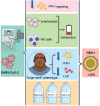Herpes Simplex Virus 1 (HSV-1) Reactivation in Critically Ill COVID-19 Patients: A Brief Narrative Review
- PMID: 35913679
- PMCID: PMC9340740
- DOI: 10.1007/s40121-022-00674-0
Herpes Simplex Virus 1 (HSV-1) Reactivation in Critically Ill COVID-19 Patients: A Brief Narrative Review
Abstract
Systemic or pulmonary reactivations of herpes simplex virus 1 (HSV-1) have been reported in critically ill patients with COVID-19, posing a dilemma for clinicians in terms of their diagnostic and clinical relevance. Prevalence of HSV-1 reactivation may be as high as > 40% in this population, but with large heterogeneity across studies, likely reflecting the different samples and/or cut-offs for defining reactivation. There is frequently agreement on the clinical significance of HSV-1 reactivation in the presence of severe manifestations clearly attributable to the virus. However, the clinical implications of HSV-1 reactivations in the absence of manifest signs and symptoms remain controversial. Our review aims at providing immunological background and at reviewing clinical findings on HSV-1 reactivations in critically ill patients with COVID-19.
Keywords: COVID-19; HSV; Herpes simplex; ICU; Pneumonia; Reactivation; SARS-CoV-2.
© 2022. The Author(s).
Figures


Similar articles
-
Epstein-Barr virus, Cytomegalovirus, and Herpes Simplex-1/2 reactivations in critically ill patients with COVID-19.Intensive Care Med Exp. 2024 Apr 22;12(1):40. doi: 10.1186/s40635-024-00624-9. Intensive Care Med Exp. 2024. PMID: 38649512 Free PMC article.
-
Reactivation of Herpes Simplex Virus Type 1 (HSV-1) Detected on Bronchoalveolar Lavage Fluid (BALF) Samples in Critically Ill COVID-19 Patients Undergoing Invasive Mechanical Ventilation: Preliminary Results from Two Italian Centers.Microorganisms. 2022 Feb 4;10(2):362. doi: 10.3390/microorganisms10020362. Microorganisms. 2022. PMID: 35208817 Free PMC article.
-
HSV-1 reactivation is associated with an increased risk of mortality and pneumonia in critically ill COVID-19 patients.Crit Care. 2021 Dec 6;25(1):417. doi: 10.1186/s13054-021-03843-8. Crit Care. 2021. PMID: 34872611 Free PMC article.
-
COVID-19, SARS-CoV-2 Vaccination, and Human Herpesviruses Infections.Vaccines (Basel). 2023 Jan 20;11(2):232. doi: 10.3390/vaccines11020232. Vaccines (Basel). 2023. PMID: 36851110 Free PMC article. Review.
-
Herpes Simplex Virus Type 1 Pneumonia-A Review.J Intensive Care Med. 2021 Dec;36(12):1398-1402. doi: 10.1177/0885066620965941. Epub 2021 Apr 29. J Intensive Care Med. 2021. PMID: 33926298 Review.
Cited by
-
COVID-19 omicron variant outbreak in a hematopoietic stem cell transplant unit.Int J Hematol. 2023 Nov;118(5):652-655. doi: 10.1007/s12185-023-03638-3. Epub 2023 Aug 2. Int J Hematol. 2023. PMID: 37532827 Free PMC article.
-
AMPK protects endothelial cells against HSV-1 replication via inhibition of mTORC1 and ACC1.Microbiol Spectr. 2023 Sep 13;11(5):e0041723. doi: 10.1128/spectrum.00417-23. Online ahead of print. Microbiol Spectr. 2023. PMID: 37702499 Free PMC article.
-
Low Prevalence of HSV-1 and Helicobacter pylori in HNSCC and Chronic Tonsillitis Patients Compared to Healthy Individuals.Diagnostics (Basel). 2023 May 19;13(10):1798. doi: 10.3390/diagnostics13101798. Diagnostics (Basel). 2023. PMID: 37238282 Free PMC article.
-
SARS-CoV-2 Induced Herpes Virus Reactivations and Related Implications in Oncohematology: When Lymphocytopenia Sets in and Immunosurveillance Drops Out.Microorganisms. 2023 Sep 1;11(9):2223. doi: 10.3390/microorganisms11092223. Microorganisms. 2023. PMID: 37764067 Free PMC article.
-
The synergistic role of viral infection and immune response in the pathogenesis of facial palsy.J Neurovirol. 2025 Jun;31(3):208-218. doi: 10.1007/s13365-025-01258-7. Epub 2025 May 15. J Neurovirol. 2025. PMID: 40374879 Free PMC article. Review.
References
Publication types
LinkOut - more resources
Full Text Sources
Miscellaneous

